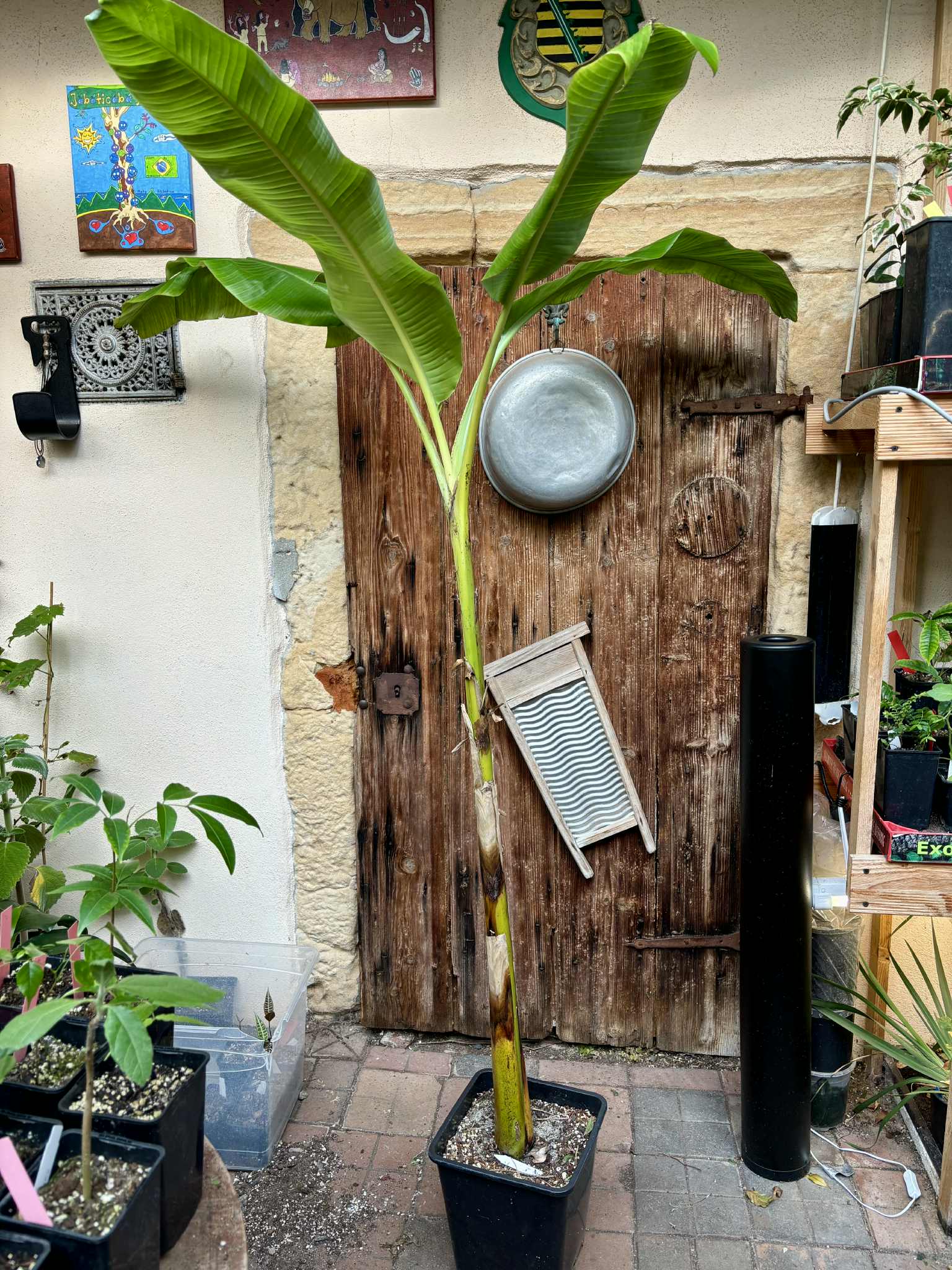1000 Finger Banana (Musa chiliocarpa) - 1 potted plant / 1 getopfte Pflanze
1000 Finger Banana (Musa chiliocarpa)
Family / Familie: Musaceae
origin from / Herkunft: Asia / Asien
Climate / Klima: temperate to warm (15-30C / 64-86F) / gemäßigt bis warm (15-30C / 64-86F)
Use / Verwendung: edible fruits, juice, jam, ice cream, etc. / essbare Früchte, Säfte, Marmelade, Eis usw.
you buy / sie kaufen: 1 potted plant / 1 getopfte Pflanze
Delivery EU only
This plant is over 2 meters tall. Therefore, the leaves are bent downwards during transport.
If a leaf breaks, this is not a problem for this plant, as new leaves are constantly forming from the center and the outer leaves die off.
The Thousand-Finger Banana (Musa chiliocarpa) is a variety known for its extremely long fruit clusters with hundreds to thousands of small, finger-sized fruits.
This variety originates from Southeast Asia and is often cultivated for its ornamental value, with the fruits serving as decoration, but also being edible and sweet.
The fruits are smaller than those of the Cavendish banana and have a milder sweetness, but are still readily eaten.
Characteristics of the Thousand-Finger Banana
Appearance: The fruit clusters can reach the ground and contain up to 1,000 small bananas, which is why it bears this name.
The individual fruits are about finger-sized.
Taste and Texture: Although it is used as an ornamental plant, the fruits are edible, have a soft texture, and a sweet taste, similar to regular bananas.
The taste is described as sweet, but not excessively sweet, with possible floral or vanilla-like notes.
Cultivation: It grows in tropical and subtropical climates and can reach an impressive height of up to 4 meters.
The plant requires water and fertilizer for strong growth.
Uses: The Thousand-Finger Banana is a curiosity for fruit lovers and gardeners.
As an ornamental plant, it is attractive because of its unusual shape and the abundance of fruits.
The fruits themselves can be eaten fresh, dried, or used in desserts.
Please overwinter at a minimum temperature of 10 degrees Celsius.
Diese Pflanze ist über 2 Meter groß. Daher werden beim Transport die Blätter nach unten gebogen.
Sollte ein Blatt brechen, ist das für diese Pflanze kein Problem, da ständig von der Mitte neue Blätter gebildet werden und die äußeren Blätter absterben.
Die Tausend-Finger-Banane (Musa chiliocarpa) ist eine Sorte, die für ihre extrem langen Fruchtstände mit Hunderten bis Tausenden von kleinen, fingergroßen Früchten bekannt ist.
Diese Sorte stammt aus Südostasien und wird oft wegen ihres ornamentalen Werts angebaut, wobei die Früchte als Zierde dienen, aber auch essbar und süß sind.
Die Früchte sind kleiner als bei der Cavendish-Banane und haben eine mildere Süße, werden aber dennoch gern gegessen.
Merkmale der Tausend-Finger-Banane
Aussehen: Die Fruchtstände können bis zum Boden reichen und bis zu 1.000 kleine Bananen enthalten, weshalb sie diesen Namen trägt.
Die einzelnen Früchte sind etwa fingergroß.
Geschmack und Textur: Obwohl sie als Zierpflanze verwendet wird, sind die Früchte essbar, haben eine weiche Textur und einen süßen Geschmack, ähnlich wie normale Bananen.
Der Geschmack wird als süß, aber nicht übermäßig süß beschrieben, mit möglichen floralen oder vanilleartigen Noten.
Anbau: Sie wächst in tropischen und subtropischen Klimazonen und kann eine beeindruckende Höhe bis 4m erreichen.
Die Pflanze benötigt Wasser und Dünger für ein starkes Wachstum.
Verwendung: Die Tausend-Finger-Banane ist eine Kuriosität für Liebhaber von Obst und Gärtnern.
Als Zierpflanze ist sie wegen ihrer ungewöhnlichen Form und der Fülle an Früchten attraktiv.
Die Früchte selbst können frisch verzehrt, getrocknet oder für Desserts verwendet werden.
Bitte bei mindestens 10 Grad überwintern.



